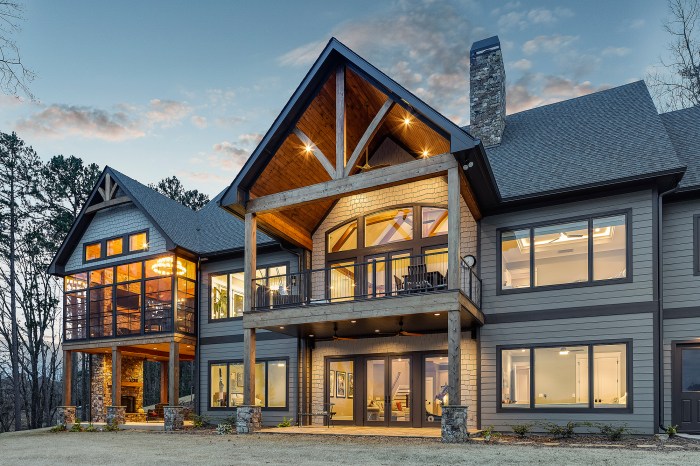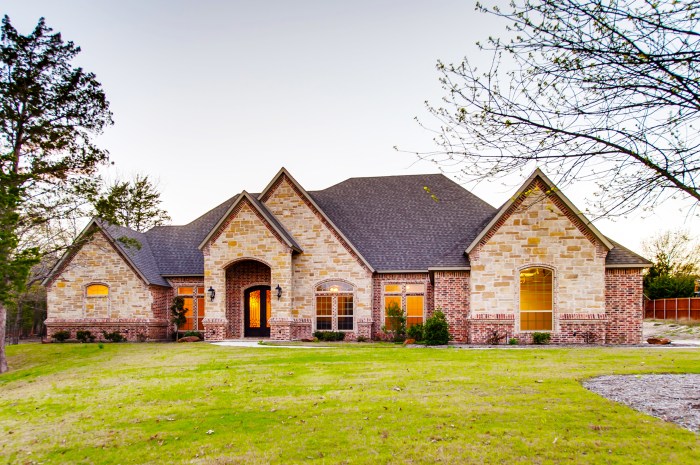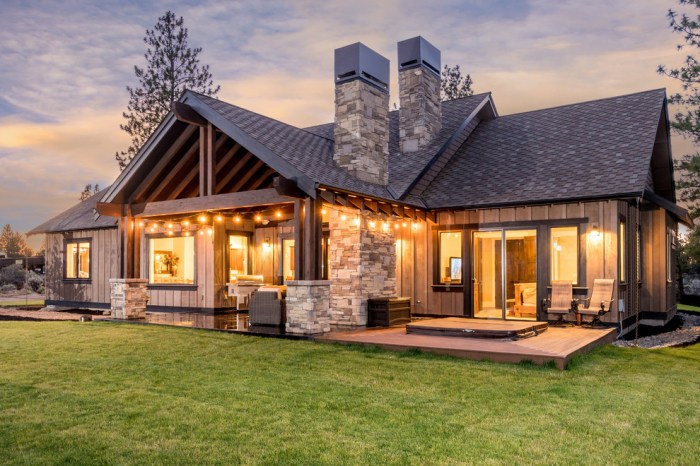Embarking on a journey through the realm of custom home exteriors, this initial glimpse invites readers to explore a world where personalized design meets functionality, resulting in homes that are truly one-of-a-kind.
Delve into the intricacies of customizing exteriors, from enhancing curb appeal to reflecting individual style and preferences, setting the stage for a captivating discussion ahead.
Importance of Custom Home Exteriors
Customizing home exteriors is crucial as it allows homeowners to tailor their living space to their unique preferences and style. By personalizing the exterior of a home, individuals can create a welcoming and aesthetically pleasing environment that reflects their personality.
Enhanced Curb Appeal
Custom exteriors play a significant role in enhancing the curb appeal of a home. By choosing specific colors, materials, and designs, homeowners can make their property stand out in the neighborhood. This not only adds value to the home but also creates a lasting impression on visitors and potential buyers.
Reflecting Homeowners’ Style and Preferences
Personalized exteriors are a reflection of the homeowners' taste, lifestyle, and values. Whether it's a modern, traditional, or eclectic design, the exterior of a home can communicate a lot about the people living inside. By customizing the exterior, individuals can showcase their unique identity and create a space that feels truly their own.
Design Elements in Custom Home Exteriors

When it comes to custom home exteriors, there are several key design elements that play a crucial role in creating a visually appealing and functional space. These design elements include the use of materials, architectural styles, colors, textures, and landscaping.
Each of these elements contributes to the overall aesthetic and functionality of a custom home exterior.
Materials Impacting Exterior Design
The materials used in custom home exteriors have a significant impact on the overall design. For example, brick and stone are often used for a traditional and timeless look, while metal and glass can create a more modern and sleek appearance.
Wood siding adds warmth and texture to a home, while stucco provides a smooth and clean finish. The choice of materials can also affect the durability and maintenance requirements of the exterior features.
Architectural Styles in Custom Home Exteriors
There are various architectural styles commonly used in custom home exteriors, each with its own unique characteristics and features. Some popular styles include:
Traditional
characterized by classic elements such as gabled roofs, dormer windows, and columns.
Modern
known for its clean lines, open spaces, and minimalistic design.
Mediterranean
featuring stucco walls, tile roofs, and arched doorways.
Craftsman
showcasing handcrafted details, exposed beams, and tapered columns.These architectural styles influence the overall look and feel of a custom home exterior, reflecting the homeowner's taste and preferences. By carefully selecting design elements, materials, and architectural styles, homeowners can create a personalized and inviting exterior that enhances the curb appeal of their home.
Energy Efficiency in Custom Home Exteriors

Energy efficiency plays a crucial role in custom home exteriors, not only reducing utility bills but also minimizing the environmental impact of the property. By incorporating eco-friendly materials and technologies, along with proper insulation and window placement, homeowners can create a sustainable and energy-efficient living space.
Eco-Friendly Materials and Technologies
When designing custom home exteriors with energy efficiency in mind, it is essential to consider using eco-friendly materials and technologies
- High-performance insulation materials such as spray foam or cellulose insulation to reduce heat loss and maintain a comfortable indoor temperature.
- Energy-efficient windows with low-E coatings and double or triple panes to minimize heat transfer and enhance natural lighting.
- Solar panels or solar shingles to harness renewable energy and reduce reliance on traditional power sources.
- Reflective roofing materials to deflect sunlight and reduce heat absorption, decreasing the need for air conditioning.
Insulation and Window Placement for Energy Savings
Proper insulation and strategic window placement are key factors in maximizing energy efficiency in custom home exteriors:
- Insulation helps prevent heat transfer through walls, floors, and ceilings, reducing the workload on heating and cooling systems.
- Well-insulated windows and doors with weather-stripping can prevent drafts and maintain a consistent indoor temperature, lowering energy consumption.
- Strategic window placement allows for natural ventilation and daylighting, reducing the need for artificial lighting and improving indoor air quality.
Maintenance Tips for Custom Home Exteriors
Regular maintenance is key to preserving the beauty and integrity of your custom home exteriors. By following some best practices and staying on top of upkeep, you can ensure that your home looks its best for years to come.
Importance of Regular Inspections
Regular inspections of your custom home exteriors are crucial to catch any issues early on before they escalate into larger problems. By inspecting the exterior of your home at least once a year, you can identify any areas that may need attention and address them promptly.
Best Practices for Upkeep
- Regularly clean the exterior surfaces of your home to remove dirt, grime, and debris that can accumulate over time.
- Inspect the paint or finish of your custom exterior for any signs of peeling, cracking, or fading, and touch up as needed.
- Trim back any vegetation that may be encroaching on your home to prevent damage to the exterior surfaces.
- Check for any signs of water damage, such as mold or mildew, and address the issue promptly to prevent further damage.
- Consider applying a fresh coat of sealant or protective finish to your custom exterior every few years to maintain its appearance and protect it from the elements.
Weather Conditions and Maintenance
Weather conditions can have a significant impact on the maintenance of custom home exteriors. Exposure to harsh sunlight, heavy rain, snow, and extreme temperatures can wear down finishes and materials over time. It's important to take these factors into consideration when planning your maintenance routine and to address any weather-related damage promptly.
Ending Remarks

Concluding our exploration of custom home exteriors, we've unraveled the importance of design elements, energy efficiency, and maintenance tips that shape these unique spaces. From eco-friendly materials to architectural styles, each aspect contributes to creating homes that stand out in both form and function.
Questions and Answers
How can custom home exteriors enhance curb appeal?
Custom exteriors add a personal touch, reflecting the homeowners' unique style and creating a standout presence in the neighborhood.
What are some common energy-efficient features for custom home exteriors?
Examples include using eco-friendly materials, proper insulation, and strategic window placement to optimize energy savings.
Why is regular maintenance crucial for custom home exteriors?
Regular inspections and upkeep help preserve the exterior finishes, ensuring longevity and minimizing potential damage from varying weather conditions.







